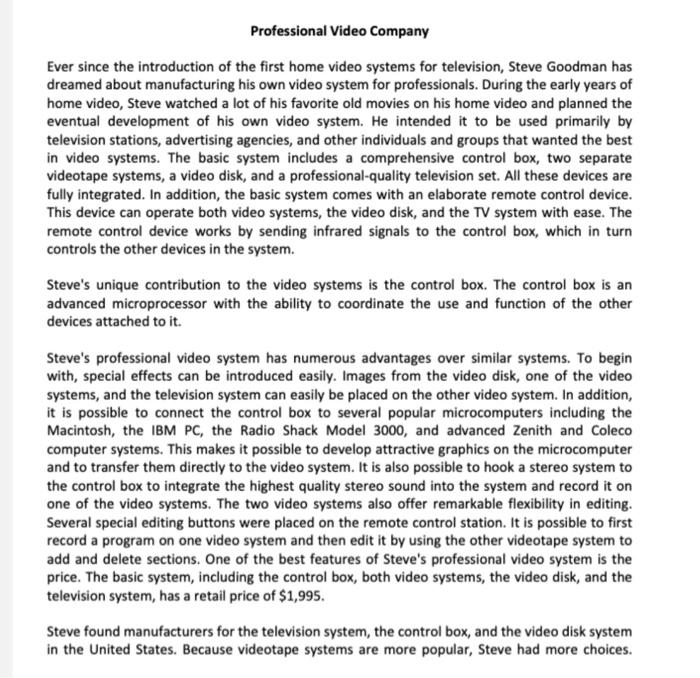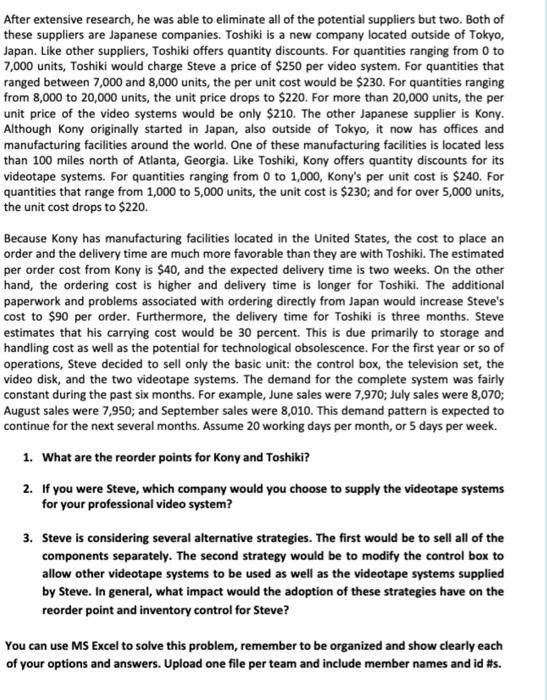Inventory management

Professional Video Company Ever since the introduction of the first home video systems for television, Steve Goodman has dreamed about manufacturing his own video system for professionals. During the early years of home video, Steve watched a lot of his favorite old movies on his home video and planned the eventual development of his own video system. He intended it to be used primarily by television stations, advertising agencies, and other individuals and groups that wanted the best in video systems. The basic system includes a comprehensive control box, two separate videotape systems, a video disk, and a professional-quality television set. All these devices are fully integrated. In addition, the basic system comes with an elaborate remote control device. This device can operate both video systems, the video disk, and the TV system with ease. The remote control device works by sending infrared signals to the control box, which in turn controls the other devices in the system. Steve's unique contribution to the video systems is the control box. The control box is an advanced microprocessor with the ability to coordinate the use and function of the other devices attached to it. Steve's professional video system has numerous advantages over similar systems. To begin with, special effects can be introduced easily. Images from the video disk, one of the video systems, and the television system can easily be placed on the other video system. In addition, it is possible to connect the control box to several popular microcomputers including the Macintosh, the IBM PC, the Radio Shack Model 3000, and advanced Zenith and Coleco computer systems. This makes it possible to develop attractive graphics on the microcomputer and to transfer them directly to the video system. It is also possible to hook a stereo system to the control box to integrate the highest quality stereo sound into the system and record it on one of the video systems. The two video systems also offer remarkable flexibility in editing. Several special editing buttons were placed on the remote control station. It is possible to first record a program on one video system and then edit it by using the other videotape system to add and delete sections. One of the best features of Steve's professional video system is the price. The basic system, including the control box, both video systems, the video disk, and the television system, has a retail price of $1,995. Steve found manufacturers for the television system, the control box, and the video disk system in the United States. Because videotape systems are more popular, Steve had more choices. After extensive research, he was able to eliminate all of the potential suppliers but two. Both of these suppliers are Japanese companies. Toshiki is a new company located outside of Tokyo, Japan. Like other suppliers, Toshiki offers quantity discounts. For quantities ranging from 0 to 7,000 units, Toshiki would charge Steve a price of $250 per video system. For quantities that ranged between 7,000 and 8,000 units, the per unit cost would be $230. For quantities ranging from 8,000 to 20,000 units, the unit price drops to $220. For more than 20,000 units, the per unit price of the video systems would be only $210. The other Japanese supplier is Kony. Although Kony originally started in Japan, also outside of Tokyo, it now has offices and manufacturing facilities around the world. One of these manufacturing facilities is located less than 100 miles north of Atlanta, Georgia. Like Toshiki, Kony offers quantity discounts for its videotape systems. For quantities ranging from 0 to 1,000 , Kony's per unit cost is $240. For quantities that range from 1,000 to 5,000 units, the unit cost is $230; and for over 5,000 units, the unit cost drops to $220. Because Kony has manufacturing facilities located in the United States, the cost to place an order and the delivery time are much more favorable than they are with Toshiki. The estimated per order cost from Kony is $40, and the expected delivery time is two weeks. On the other hand, the ordering cost is higher and delivery time is longer for Toshiki. The additional paperwork and problems associated with ordering directly from Japan would increase Steve's cost to $90 per order. Furthermore, the delivery time for Toshiki is three months. Steve estimates that his carrying cost would be 30 percent. This is due primarily to storage and handling cost as well as the potential for technological obsolescence. For the first year or so of operations, Steve decided to sell only the basic unit: the control box, the television set, the video disk, and the two videotape systems. The demand for the complete system was fairly constant during the past six months. For example, June sales were 7,970; July sales were 8,070 ; August sales were 7,950; and September sales were 8,010 . This demand pattern is expected to continue for the next several months. Assume 20 working days per month, or 5 days per week. 1. What are the reorder points for Kony and Toshiki? 2. If you were Steve, which company would you choose to supply the videotape systems for your professional video system? 3. Steve is considering several alternative strategies. The first would be to sell all of the components separately. The second strategy would be to modify the control box to allow other videotape systems to be used as well as the videotape systems supplied by Steve. In general, what impact would the adoption of these strategies have on the reorder point and inventory control for Steve? You can use MS Excel to solve this problem, remember to be organized and show clearly each of your options and answers. Upload one file per team and include member names and id \#s. Professional Video Company Ever since the introduction of the first home video systems for television, Steve Goodman has dreamed about manufacturing his own video system for professionals. During the early years of home video, Steve watched a lot of his favorite old movies on his home video and planned the eventual development of his own video system. He intended it to be used primarily by television stations, advertising agencies, and other individuals and groups that wanted the best in video systems. The basic system includes a comprehensive control box, two separate videotape systems, a video disk, and a professional-quality television set. All these devices are fully integrated. In addition, the basic system comes with an elaborate remote control device. This device can operate both video systems, the video disk, and the TV system with ease. The remote control device works by sending infrared signals to the control box, which in turn controls the other devices in the system. Steve's unique contribution to the video systems is the control box. The control box is an advanced microprocessor with the ability to coordinate the use and function of the other devices attached to it. Steve's professional video system has numerous advantages over similar systems. To begin with, special effects can be introduced easily. Images from the video disk, one of the video systems, and the television system can easily be placed on the other video system. In addition, it is possible to connect the control box to several popular microcomputers including the Macintosh, the IBM PC, the Radio Shack Model 3000, and advanced Zenith and Coleco computer systems. This makes it possible to develop attractive graphics on the microcomputer and to transfer them directly to the video system. It is also possible to hook a stereo system to the control box to integrate the highest quality stereo sound into the system and record it on one of the video systems. The two video systems also offer remarkable flexibility in editing. Several special editing buttons were placed on the remote control station. It is possible to first record a program on one video system and then edit it by using the other videotape system to add and delete sections. One of the best features of Steve's professional video system is the price. The basic system, including the control box, both video systems, the video disk, and the television system, has a retail price of $1,995. Steve found manufacturers for the television system, the control box, and the video disk system in the United States. Because videotape systems are more popular, Steve had more choices. After extensive research, he was able to eliminate all of the potential suppliers but two. Both of these suppliers are Japanese companies. Toshiki is a new company located outside of Tokyo, Japan. Like other suppliers, Toshiki offers quantity discounts. For quantities ranging from 0 to 7,000 units, Toshiki would charge Steve a price of $250 per video system. For quantities that ranged between 7,000 and 8,000 units, the per unit cost would be $230. For quantities ranging from 8,000 to 20,000 units, the unit price drops to $220. For more than 20,000 units, the per unit price of the video systems would be only $210. The other Japanese supplier is Kony. Although Kony originally started in Japan, also outside of Tokyo, it now has offices and manufacturing facilities around the world. One of these manufacturing facilities is located less than 100 miles north of Atlanta, Georgia. Like Toshiki, Kony offers quantity discounts for its videotape systems. For quantities ranging from 0 to 1,000 , Kony's per unit cost is $240. For quantities that range from 1,000 to 5,000 units, the unit cost is $230; and for over 5,000 units, the unit cost drops to $220. Because Kony has manufacturing facilities located in the United States, the cost to place an order and the delivery time are much more favorable than they are with Toshiki. The estimated per order cost from Kony is $40, and the expected delivery time is two weeks. On the other hand, the ordering cost is higher and delivery time is longer for Toshiki. The additional paperwork and problems associated with ordering directly from Japan would increase Steve's cost to $90 per order. Furthermore, the delivery time for Toshiki is three months. Steve estimates that his carrying cost would be 30 percent. This is due primarily to storage and handling cost as well as the potential for technological obsolescence. For the first year or so of operations, Steve decided to sell only the basic unit: the control box, the television set, the video disk, and the two videotape systems. The demand for the complete system was fairly constant during the past six months. For example, June sales were 7,970; July sales were 8,070 ; August sales were 7,950; and September sales were 8,010 . This demand pattern is expected to continue for the next several months. Assume 20 working days per month, or 5 days per week. 1. What are the reorder points for Kony and Toshiki? 2. If you were Steve, which company would you choose to supply the videotape systems for your professional video system? 3. Steve is considering several alternative strategies. The first would be to sell all of the components separately. The second strategy would be to modify the control box to allow other videotape systems to be used as well as the videotape systems supplied by Steve. In general, what impact would the adoption of these strategies have on the reorder point and inventory control for Steve? You can use MS Excel to solve this problem, remember to be organized and show clearly each of your options and answers. Upload one file per team and include member names and id \#s









